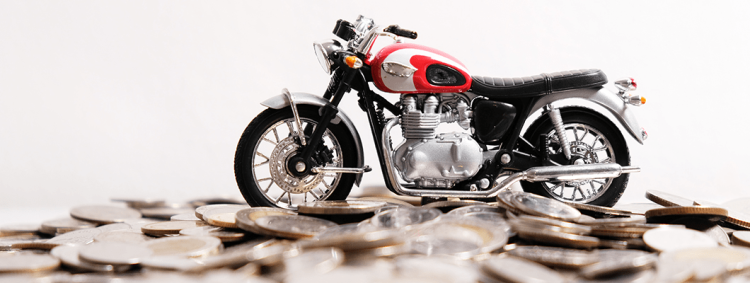Acquiring a second-hand two-wheeler through a loan can be a practical and cost-effective way to fulfil your transportation needs. However, navigating the process of buying a pre-owned bike on Equated Monthly Instalments (EMI) requires careful consideration and understanding. In this comprehensive guide, we will explore the key aspects you need to know before venturing into the world of financing a used motorcycle.
Check Your Budget and Affordability
Before diving into the world of pre-owned two-wheeler financing, conduct a thorough assessment of your current financial situation. Calculate your monthly income, account for existing financial commitments, and determine how much you can comfortably allocate towards paying the set EMIs.
Owning a bike involves more than just the EMI payments. Factor in additional costs such as insurance, maintenance, fuel, and registration fees. Ensuring that you can afford the overall ownership costs is crucial for a sustainable financial commitment.
Assess the Used Two-wheeler
Before finalising your decision, research the specific two-wheeler model you are interested in. Consider factors such as mileage, maintenance costs, and user reviews to ensure that it meets your expectations.
Request the vehicle’s history report, which can reveal crucial information about accidents, ownership details, and whether the bike has a clean title. A comprehensive vehicle history check can provide peace of mind regarding the bike’s condition.
Physically inspect the two-wheeler or have it examined by a trusted mechanic. Look for signs of wear and tear, and check the engine, brakes, tires, and other critical components. An inspection can help you identify potential issues and negotiate a fair price.
Understand Your Creditworthiness
Your credit score plays a pivotal role in determining the interest rate you will be offered on your second-hand bike loan. Thus ensure to access a copy of your credit report and check your score regularly. A higher credit score often enables you to acquire favourable loan terms.
If your score is lower than ideal, consider taking steps to improve it before applying for a loan.
Examine your credit report for any discrepancies or errors. Rectify any inaccuracies to ensure that your credit history is accurately reflected, potentially leading to better loan offers.
Research Lenders and Loan Options
Research various banks, credit unions, and financial institutions that offer used two-wheeler loans. Compare interest rates, processing fees, and other terms to identify loan offers that align with your financial goals.
Online platforms and digital lenders often provide competitive loan offerings. Explore these options and leverage the convenience and potential cost savings they may offer.
Understand Loan Terms
Determine the loan amount you require based on the cost of the pre-owned bike. Plan for a down payment, as a higher down payment can often lead to better loan terms.
Understand the interest rate offered by the lender and the loan tenure. The interest rate directly impacts the overall cost of the loan, and the tenure determines the duration of your EMI payments. Striking a balance between a reasonable interest rate and a manageable tenure is crucial.
Be aware of any processing fees, documentation charges, or other hidden costs associated with the loan. Factor these into your budget to get a comprehensive understanding of the total loan cost.
Loan Application Process
Gather all required documents, including proof of identity, address, income, and the details of the used two-wheeler. Ensure that all documents are accurate and up-to-date to expedite the loan approval process.
Once your application is submitted, the lender will assess your eligibility and approve the loan if the eligibility criteria are met. Promptly provide any additional information or documents requested by the lender.
Negotiate with the Lender
Do not hesitate to negotiate with the lender for better terms. If you have a strong credit history or can offer a substantial down payment, use these factors to your advantage in securing favourable loan conditions.
Understand the repayment options available, including the frequency of EMI payments. Some lenders offer flexibility in choosing the EMI payment date, allowing you to align it with your salary cycle.
Be Mindful of Insurance
It is essential to have comprehensive insurance coverage for your pre-owned bike. Some lenders may offer insurance as part of the second-hand bike loan package. Evaluate the terms and consider exploring insurance options independently to secure the best coverage.
Factor in the cost of insurance when budgeting for the purchase. Insurance is a mandatory requirement, and being adequately covered safeguards you against unforeseen circumstances.
Plan for Contingencies
Build or have an existing emergency fund to cover unexpected expenses. This fund can be a financial safety net in case of unforeseen repair costs or other emergencies related to your two-wheeler.
Develop a strategy for repaying the loan efficiently. Consider making additional payments when possible to reduce the overall interest cost and pay off the bike loan sooner.
Stay Informed and Seek Guidance
Keep yourself informed about market trends, interest rate changes, and any new loan offerings. This knowledge can empower you to make informed decisions and potentially refinance your loan for better terms in the future.
If you have uncertainties or complex financial considerations, consider seeking financial advice. Get personalised guidance from professionals based on your specific situation and goals.
Buying a pre-owned two-wheeler on EMI is a viable option that allows you to own a vehicle without bearing the full cost upfront. By meticulously assessing your financial situation, researching lenders, and understanding the loan terms, you can navigate this process with confidence. Remember, informed decisions and thorough preparation are key to securing the best deal on a second-hand bike loan.
















